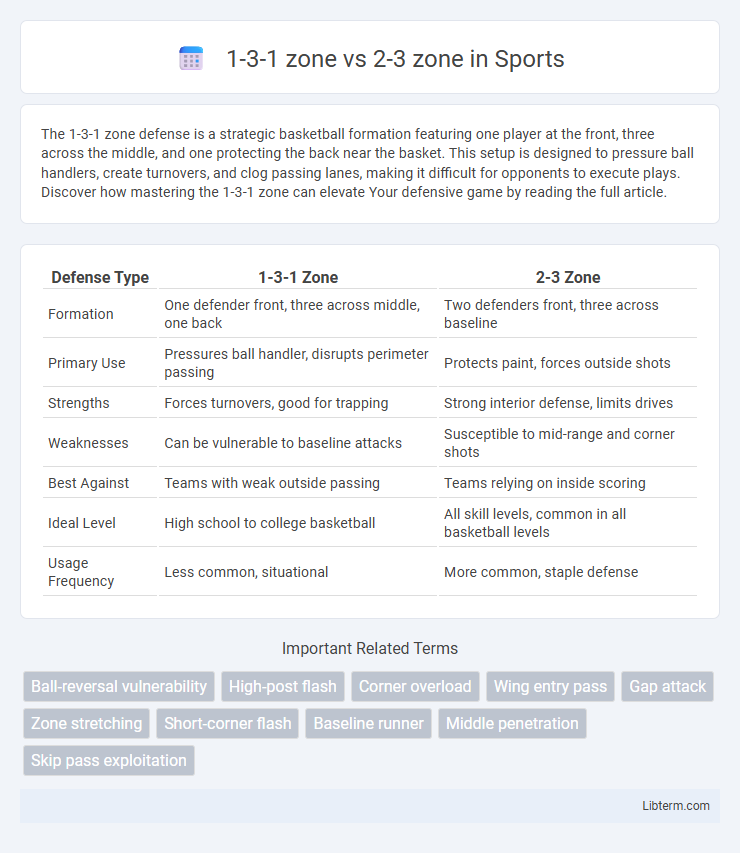The 1-3-1 zone defense is a strategic basketball formation featuring one player at the front, three across the middle, and one protecting the back near the basket. This setup is designed to pressure ball handlers, create turnovers, and clog passing lanes, making it difficult for opponents to execute plays. Discover how mastering the 1-3-1 zone can elevate Your defensive game by reading the full article.
Table of Comparison
| Defense Type | 1-3-1 Zone | 2-3 Zone |
|---|---|---|
| Formation | One defender front, three across middle, one back | Two defenders front, three across baseline |
| Primary Use | Pressures ball handler, disrupts perimeter passing | Protects paint, forces outside shots |
| Strengths | Forces turnovers, good for trapping | Strong interior defense, limits drives |
| Weaknesses | Can be vulnerable to baseline attacks | Susceptible to mid-range and corner shots |
| Best Against | Teams with weak outside passing | Teams relying on inside scoring |
| Ideal Level | High school to college basketball | All skill levels, common in all basketball levels |
| Usage Frequency | Less common, situational | More common, staple defense |
Introduction to Basketball Zone Defenses
The 1-3-1 zone defense in basketball features one defender at the point, three across the middle, and one near the basket, emphasizing perimeter pressure and trapping opportunities. In contrast, the 2-3 zone defense places two players at the top and three near the baseline, focusing on protecting the paint and forcing outside shots. Each zone defense aims to disrupt offensive rhythms but requires specific positioning and communication to effectively counter different offensive strategies.
Overview of the 1-3-1 Zone Defense
The 1-3-1 zone defense arranges players in a formation with one defender at the top, three across the middle, and one at the baseline, designed to apply pressure on the perimeter and disrupt passing lanes. This setup emphasizes quick rotations and active hands to create turnovers and force contested shots from the outside. Compared to the 2-3 zone, the 1-3-1 offers greater defensive aggression and flexibility in trapping opponents, making it effective against teams reliant on outside shooting and ball movement.
Overview of the 2-3 Zone Defense
The 2-3 zone defense positions two players at the perimeter and three near the paint, creating a formidable barrier against inside scoring and forcing opponents into low-percentage perimeter shots. This setup enhances rebounding capabilities and protects the basket more effectively than the 1-3-1 zone, which prioritizes perimeter pressure but is vulnerable inside. Teams using the 2-3 zone benefit from its balanced coverage and adaptability to various offensive strategies in basketball.
Key Differences Between 1-3-1 and 2-3 Zones
The 1-3-1 zone defense in basketball features one defender at the point, three across the middle, and one near the baseline, emphasizing perimeter pressure and traps in the corners. In contrast, the 2-3 zone places two defenders at the top and three near the basket, focusing on protecting the paint and forcing outside shots. Key differences include 1-3-1's aggressive perimeter containment and trapping ability versus 2-3's stronger interior defense and rebounding positioning.
Strengths of the 1-3-1 Zone
The 1-3-1 zone defense excels in disrupting offensive rhythm with its unique alignment, applying intense perimeter pressure and forcing turnovers through aggressive trapping. Its design allows for quick rotations and effective coverage of passing lanes, making it ideal for teams with athletically versatile defenders. This zone creates challenges for opponents trying to execute inside-out plays, often leading to contested shots and limited high-percentage scoring opportunities.
Strengths of the 2-3 Zone
The 2-3 zone defense excels at protecting the paint by positioning three defenders near the basket, effectively clogging the interior and forcing opponents into contested outside shots. This formation maximizes rebounding opportunities and limits penetration, making it particularly strong against teams reliant on inside scoring. Its balanced coverage along the baseline and perimeter also challenges corner and baseline shooters more effectively than the 1-3-1 zone.
Common Weaknesses of Each Zone
The 1-3-1 zone defense often struggles with perimeter shooters exploiting the extended corners and wings, leaving gaps that skilled outside shooters can target. The 2-3 zone is commonly vulnerable in the high post area, where quick passes and good ball movement can create open mid-range shots or penetrative lanes. Both zones suffer from potential lapses in interior defense if defenders fail to communicate effectively and rotate quickly to cover open players.
Best Situations to Use 1-3-1 vs 2-3 Zone
The 1-3-1 zone defense excels in creating turnovers and disrupting perimeter passing lanes, making it ideal against teams relying heavily on outside shooting and quick ball movement. The 2-3 zone offers stronger interior protection, effectively defending against post plays and opponents with strong inside scorers, especially when facing teams with dominant big men. Coaches often deploy the 1-3-1 in transition or when needing to increase defensive pressure, while the 2-3 zone is optimal for conserving energy and controlling the paint against balanced scoring threats.
Offensive Strategies Against These Zones
Attacking a 1-3-1 zone defense requires quick ball movement and perimeter shooting to exploit the weak spots along the baseline and corners, using skips and flash cuts to penetrate the top defender's area. Against a 2-3 zone, offensive strategies focus on high post play and short corner shooting, aiming to overload the gaps between the bottom three defenders while utilizing dribble penetration to collapse the zone. Effective offenses against both zones often incorporate strong spacing, timely backdoor cuts, and coordinated screens to disrupt defensive rotations and create open shooting opportunities.
Choosing the Right Zone Defense for Your Team
The 1-3-1 zone defense effectively pressures the perimeter and disrupts passing lanes, ideal for teams with quick, agile defenders. The 2-3 zone provides stronger interior protection and rebounding, making it suitable for teams with taller players focused on controlling the paint. Selecting the right zone defense depends on your team's physical attributes and the opponent's offensive strengths.
1-3-1 zone Infographic

 libterm.com
libterm.com